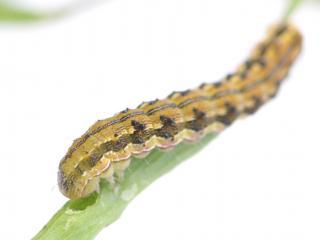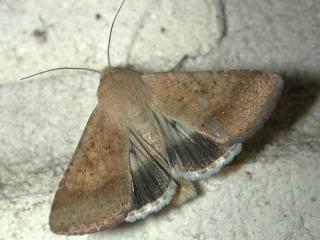Native budworm moth update
Caterpillar activity
- Maya
- Tammin
- Dale
- Aldersyde
- Wyalkatchem
- Cadoux
- Kellerberrin
- Bolgart
- Calingiri
- Toodyay
- Northam
- York
- Corrigin
A farmer near Maya used a sweep net to monitor a lupin crop at the leaf drop stage and found, on average, one budworm caterpillar per 10 sweeps, however he noticed that quite a few pods had surface chewing damage. He then selected a number of plants and shook them into a large container, the subsequent calculations indicated there were 12 budworm grubs per square metre in the crop.
David Stead (Anasazi Agronomy) reports finding 10-25 budworm caterpillars per 10 sweeps in canola crops north of Tammin, eight caterpillars per 10 sweeps near Dale and 7-12 caterpillars per 10 sweeps in canola near Aldersyde. David has also been hearing of budworm caterpillars in lupin crops at Wyalkatchem and Cadoux.
A farmer and budworm trapper south of Wyalkatchem has used a sweep net to monitor a lupin crop and found above threshold numbers of budworm caterpillars earlier this week. A control spray will be applied over the weekend.
A farmer south of Kellerberrin reports finding 3-5 grubs per 10 sweeps in canola and lupin crops.
A GRDC GrowNotes Alert was distributed this week urging growers to check pulse and canola crops in northern and some central cropping areas of WA for above threshold levels of budworm caterpillars. This has prompted Twitter reports of budworm caterpillars being generally widespread throughout the areas of Bolgart, Calingiri and Toodyay.
Technical officer Dave Nicholson (DPIRD) has found the following numbers of budworm caterpillars (all less than 1cm long) in 10 sweeps in podding lupins: one at Northam, 60 at York and one at Corrigin. He found none in late flowering/podding canola at Wickepin and Pingelly.
As lupins near maturity it can be difficult to use a sweep net as the plants are stiff and the pods are spiky. An alternative to sweeping is to cut plants from several places in the crop and shake them into a bin to count caterpillar numbers. Taking small areas from the crop, say a quarter or a tenth of a square metre, or a number of plants equal to that found in a square metre, is the easiest method for assessing damage levels for the entire crop. Narrow-leafed lupin crops will not be damaged until they are close to maturity and the pods are losing their green colouration. Pod walls are not penetrated until the caterpillars are over 15mm in length. Budworm caterpillars will continue to cause damage to lupins until the seed is near the hard ripe stage
With canola and pulse crops smaller caterpillars are able to easily chew into the thinner pod walls. Native budworm can also cause damage after a canola crop has been swathed. This will occur if the crop is swathed when many pods are still green with soft seed. Seed damage from native budworm increases in swathed crops if drying is prolonged due to cool damp conditions.
Native budworm moth surveillance
- Usual automated and manual trapping locations
The larger native budworm moth flights recorded by budworm trappers this week include; Dowerin (821 moths over 14 days), Kojonup South West (460), Pingrup (390 over 14 days), Merredin South (286), Cuballing (270), Varley (256), Binnu (232), Kellerberrin South (230 over 14 days), Doodlakine South (220), Wyalkatchem S (170) and Badgingarra North East (164).
Results of this week's automated and manual trappings are available at the department’s Native budworm moth numbers 2018.
A mapped view of the native budworm trap captures is available at cesar’s MothTrapVisWA page. Viewers need to select the desired trapping date range.
For more information on native budworm refer to DPIRD’s 2018 PestFax Issue 22 article Native budworm moth flights are increasing in numbers and distribution and Management and economic thresholds for native budworm page.
Be mindful of withholding periods near harvest
Farmers with native budworm caterpillars in their crops need to be mindful of insecticide withholding periods (WHP) close to harvest and remember that windrowing is classified as harvest.
For more information on insecticides refer to the department’s Winter/Spring Insecticide Spray Chart 2018.
For more information contact Alan Lord, Technical Officer, South Perth on +61 (0)8 9368 3758 or +61 (0)409 689 468.


